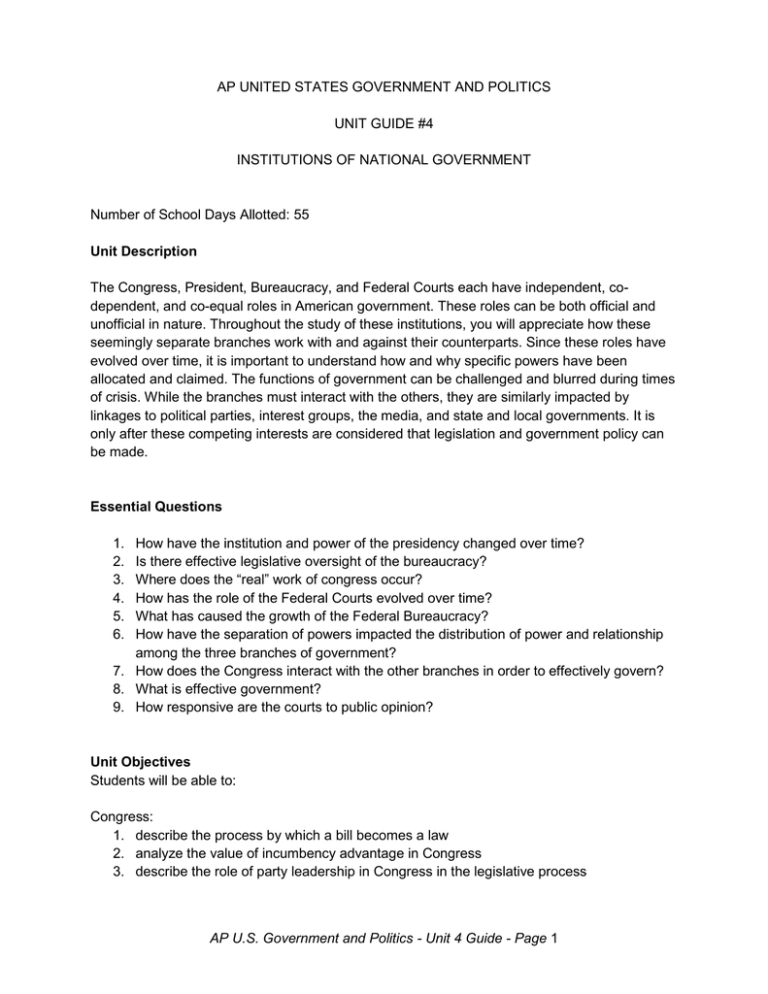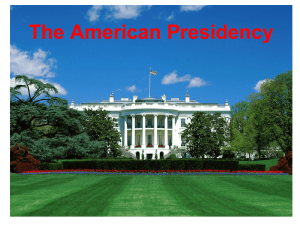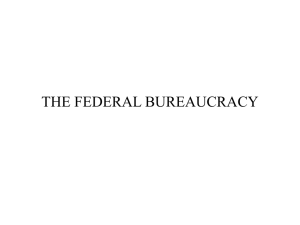AP UNITED STATES GOVERNMENT AND POLITICS UNIT GUIDE
advertisement

AP UNITED STATES GOVERNMENT AND POLITICS UNIT GUIDE #4 INSTITUTIONS OF NATIONAL GOVERNMENT Number of School Days Allotted: 55 Unit Description The Congress, President, Bureaucracy, and Federal Courts each have independent, codependent, and co-equal roles in American government. These roles can be both official and unofficial in nature. Throughout the study of these institutions, you will appreciate how these seemingly separate branches work with and against their counterparts. Since these roles have evolved over time, it is important to understand how and why specific powers have been allocated and claimed. The functions of government can be challenged and blurred during times of crisis. While the branches must interact with the others, they are similarly impacted by linkages to political parties, interest groups, the media, and state and local governments. It is only after these competing interests are considered that legislation and government policy can be made. Essential Questions 1. 2. 3. 4. 5. 6. How have the institution and power of the presidency changed over time? Is there effective legislative oversight of the bureaucracy? Where does the “real” work of congress occur? How has the role of the Federal Courts evolved over time? What has caused the growth of the Federal Bureaucracy? How have the separation of powers impacted the distribution of power and relationship among the three branches of government? 7. How does the Congress interact with the other branches in order to effectively govern? 8. What is effective government? 9. How responsive are the courts to public opinion? Unit Objectives Students will be able to: Congress: 1. describe the process by which a bill becomes a law 2. analyze the value of incumbency advantage in Congress 3. describe the role of party leadership in Congress in the legislative process AP U.S. Government and Politics - Unit 4 Guide - Page 1 4. identify how Congressional committees, and their party structure, impact the legislative process 5. describe how specialization in Congress influences the legislative process 6. analyze how reciprocity/logrolling in Congress influences the legislative process 7. analyze how strong public opinion as expressed in polling results and competitive reelections enhance the influence of public opinion on the voting decisions of members of Congress 8. explain why legislators’ voting records and party leadership limits the influence of public opinion on the voting decisions of members of congress 9. describe significant functional duties of the members of Congress, including constituent services 10. identify barriers in Congress that impede minority representation 11. analyze the role of the Senate filibuster in legislation and negotiations 12. analyze how the house rules committee and conference committees impact lawmaking 13. discuss the importance of congressional reapportionment of the states, redistricting, and gerrymandering 14. identify rules within each chamber of the legislative branch that independently influence the likelihood that legislation will pass in that chamber 15. identify advantages that the majority party in the House has in lawmaking above and beyond the numerical advantage that the majority party enjoys in floor voting 16. analyze the impact of the legislative veto Presidency 1. analyze factors that decrease and increase presidential approval ratings 2. describe the formal and informal powers of the presidency 3. explain how formal powers enable the president to exert influence over domestic policy 4. analyze limitations on the president's ability to influence domestic policymaking in Congress due to mandatory spending, party polarization, and the lame-duck period 5. explain the process by which the president selects cabinet officers and sub-cabinet positions 6. Describe the veto and pocket veto process, and examine the arguments surrounding the line-item veto Bureaucracy 1. discuss why Congress gives federal bureaucratic agencies policy--making discretion in executing federal laws 2. identify specific bureaucratic agencies that exercise policy-making power in specific areas 3. describe the merit system in the federal bureaucracy 4. explain how the structure of the federal bureaucracy and the complexity of public policy problems contribute to bureaucratic independence 5. examine redundancies in bureaucracy 6. analyze why departments are added and removed Federal Courts AP U.S. Government and Politics - Unit 4 Guide - Page 2 1. Analyze how interest groups influence the appointment of Supreme Court justices 2. explain how the SCOTUS is insulated from public opinion while at the same time not deviating too far from public opinion 3. analyze ways in which politics affects aspects of the judiciary 4. explain how judicial review empowers SCOTUS within the system of checks and balances 5. describe the process through which SCOTUS grants a writ of certiorari 6. analyze how stare decisis and judicial activism influence decisions made by individual justices when deciding cases heard by SCOTUS 7. differentiate between original and appellate jurisdiction 8. analyze the difference between strict and loose constructionism Relationships 1. Analyze the successes and failures of legislative oversight of bureaucracy 2. analyze problems caused by divided government in the appointment power of the president 3. Describe the politics involved in the appointment of Supreme Court justices 4. Identify legislative and executive checks on court decisions 5. analyze how political institutions might limit the impact of Supreme Court decisions 6. Analyze the impact of the iron triangle 7. identify ways in which Congress ensures that federal agencies follow legislative intent 8. Identify how the SCOTS has placed limits on Congressional redistricting 9. identify constitutional provisions that Congress, the courts, and interest groups can use to check the bureaucracy Reading Assignments and Study Guide Questions Lesson Topic Wilson Reading A. The major formal and informal institutional arrangements of power Congress Supplemental Readings Assessment from Instructors Manual to The Lanahan Readings in the American Polity Textbook Chapter 11 ● ● ● ● David Mayhew, “Congress: The Electoral Connection”, 147 Gregory Wawro/Eric Schickler, “Filibuster” 163 Richard Fenno, “Going Home” 177 John Ellwood/Eric AP U.S. Government and Politics - Unit 4 Guide - Page 3 ● Textbook Chapter 12 Presidency ● ● ● ● Textbook Chapter 13 Bureaucracy ● ● Textbook Chapter 14 Courts ● ● B. Relationships among these four institutions and varying balances of power ● Patashnik, “In Praise of Pork” 190 David Price, “The Congressional Experience” 201 Richard Neustadt, “Presidential Power and the Modern Presidents” 211 Arthur Schlesinger, “The Imperial Presidency” 218 Michael Cairo, “The Imperial Presidency Triumphant” 225 Bradley Patterson “The White House Staff” 264 Paul Light, “A Government Ill Executed” 282 James Wilson “Bureaucracy” 302 David Yalof, “Pursuit of Justices” 326 Richard Fallon, “The Dynamic Constitution” 333 Sarah Binder, “Stalemate,” 157 C. Linkage between institutions and the following: 1. Public opinion and voters Thomas Cronin, “Direct Democracy” 425 2. Interest groups 3. Political Parties 4. The Media 5. State and local governments AP U.S. Government and Politics - Unit 4 Guide - Page 4 Additional Reading Assessment and Accountability Strategies ● Unannounced quizzes ● Outline ● Key Issue Identification ● CLUES worksheet ● Reader Articles/Arguments comparison chart ● Vocabulary Identifications while reading Vocabulary List Congress reapportionment gerrymandering redistricting constituency services franking pork barrel earmarks committee system committee chairmen types of committees concurrent resolution conference committee markup session seniority party leadership Congressional Reassertion of Power War Powers Resolution filibuster cloture rule oversight legislative veto appropriations rules committee congressional staff incumbency non-germane amendment Ways and Means fiscal policy Presidency personal/public presidency executive order AP U.S. Government and Politics - Unit 4 Guide - Page 5 senatorial courtesy roles of the president executive privileges 22nd/25th Amendment impeachment White House Staff National Security Council Office of Management and Budget President and the media pocket veto line-item veto cabinet framers’ intent formal/informal power of the presidency Bureaucracy appropriation bureaucracy civil service iron triangle red tape types of agencies independent agencies discretionary authority bureaucratic pathologies oversight of bureaucracy government by proxy Hatch Act Courts judicial review federal court structure/jurisdiction judicial activism judicial restraint judicial appointment process/litmus test judicial conference judicial tenure writ of certiorari oral arguments political questions justiciable dispute solicitor general precedent/stare decisis strict vs. loose constructionism trial vs. appellate courts AP U.S. Government and Politics - Unit 4 Guide - Page 6 diversity cases district court circuit court criminal/civil law standing dissenting/concurring opinions Selected Unit Websites http://www.oyez.org (The Oyez Project at Chicago-Kent) http://www.congresslink.org/ (Information about the U.S. Congress) http://www.house.gov (US House of Representatives) http://www.senate.gov (US Senate) http://www.whitehouse.gov (The Presidency) http://www.supremecourt.gov/ (US Supreme Court) http://www.c-span.org (C-Span) http://www.potus.com (Presidents of the United States) http://thomas.loc.gov/home/thomas.html (Thomas-The official guide to congressional legislation.) http://ww.vote-smart.org (Vote Smart-Biographies, positions taken, and key supporters of elected public officials at the national, state, and local levels; the site also has voting records for U.S. Senators and Representatives.) http://www.nathannewman.org/nbs/ (The National Budget Simulation) http://www.theatlanticcities.com/politics/2013/01/diversity-113th-congress-looks-pathetic-whenyou-plot-it-map/4348/ (The Atlantic - Map of Diversity Representation) http://www.taxpayer.net/library/article/earmark-data (Earmark Data) AP U.S. Government and Politics - Unit 4 Guide - Page 7





